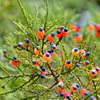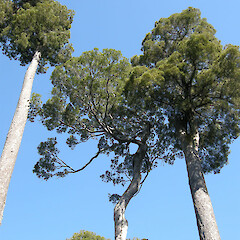Kahikatea
- 18 April 2025
Dacrycarpus dacrydioides
Common names
kahikatea, white pine
Biostatus
Native – Endemic taxon
Category
Vascular
Structural class
Trees & Shrubs - Gymnosperms
This conifer is New Zealand’s tallest indigenous plant growing up to 65m. It is found in lowland forest, formerly dominant on frequently flooded or poorly drained alluvial soils. It was once the dominant tree of a distinct swamp forest type all but extinct in the North Island—the best examples remain on the West Coast of the South Island.
Flower colours
No flowers
Detailed description
Stout, dioecious, cohort-forming conifer, 50–(65) m tall. Trunk 1–(2) m diam., often fluted and buttressed. Bark grey to dark-grey, falling in thick, sinuous flakes. Wood white, odourless. Trunks bare for ¾ of length, subadults with a distinctive columnar growth habit, branches arising from ⅓–½ trunk length. Branchlets slender, drooping. Leaves of juveniles subdistichous, subpatent, narrow-linear, subfalcate, acuminate, decurrent, 3–7 × 0.5–1mm red, wine-red, dark-green to green; of subadults less than or equal to 4 mm., dark green or red; those of adults 1–2 mm., imbricating, appressed, keel, subtrigonous, lanceolate-subulate to acuminate with broader base, brown-green or glaucous. Male cones terminal, oblong, 10 mm. Pollen pale yellow. Ovule, terminal, solitary glaucescent. Receptacle fleshy, oblong, compressed, warty, 2.5–6.5 mm, yellow to orange-red. Seed broadly obovate to circular (4)–4.5–6 mm diam., purple-black, thickly covered in glaucous bloom.
Similar taxa
A distinctive tree of usually swampy alluvial terraces. The columnar growth form of subadults, buttressed and fluted trunk bases, scale-like leaves, and terminal fruits bearing the distinctive circular seeds serve to immediately distinguish this species from all other indigenous conifers.
Distribution
Endemic. North Island, South Island and Stewart Island/Rakiura.
Habitat
Lowland forest, formerly dominant on frequently flooded, and/or poorly drained alluvial soils. Occasionally extends into lower montane forest. Once the dominant tree of a distinct swamp forest type all but extinct in the North Island—the best examples remain on the West Coast of the South Island.
Current conservation status Help
2023 | Not Threatened
Threats
Not Threatened, although as a forest-type it has been greatly reduced through widespread logging. Very few intact examples of kahikatea-dominated forest remain in the North Island.
Detailed taxonomy
Family
Authority
Dacrycarpus dacrydioides (A.Rich.) de Laub.
Synonyms
Dacrydium excelsum D.Don in Lamb., Dacrydium ferrugineum Houttee ex Gord., Dacrydium thuioides Banks et Solander ex Carr., Nageia excelsa Kuntze, Podocarpus dacrydioides Richard, Podocarpus thujoides R.Br. In Bennett, Podocarpus excelsus (D.Don) Druce; Podocarpus excelsus (D. Don.) Druce
Endemic taxon
Yes
Endemic genus
No
Endemic family
No
Ecology
Flowering
October–January
Fruiting
February–April
Propagation technique
Easily grown from fresh seed. Can be grown from hard-wood cuttings but rather slow to strike.
Wetland plant indicator status rating Help
FAC: Facultative
Commonly occurs as either a hydrophyte or non-hydrophyte (non-wetlands).
https://www.nzpcn.org.nz/flora/species/dacrycarpus-dacrydioides/


































